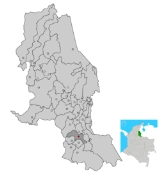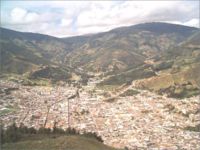
Pamplona, Colombia
Encyclopedia

Municipality
A municipality is essentially an urban administrative division having corporate status and usually powers of self-government. It can also be used to mean the governing body of a municipality. A municipality is a general-purpose administrative subdivision, as opposed to a special-purpose district...
and city in Norte de Santander, Colombia
Colombia
Colombia, officially the Republic of Colombia , is a unitary constitutional republic comprising thirty-two departments. The country is located in northwestern South America, bordered to the east by Venezuela and Brazil; to the south by Ecuador and Peru; to the north by the Caribbean Sea; to the...
.
Colonization
Nueva Pamplona del Valle del Espíritu Santo, the name by which Don Pedro de Ursúa and Don Ortún Velasco de Velázquez paid tribute to the capital of the province of NavarreNavarre
Navarre , officially the Chartered Community of Navarre is an autonomous community in northern Spain, bordering the Basque Country, La Rioja, and Aragon in Spain and Aquitaine in France...
in Spain, was founded on 1 November 1549. From they divided the expeditions there that founded - among others the populations of Mérida, San Cristóbal and the Outcry, in the sister Republic of Venezuela, and Ocaña, Salazar of the Palms, Chinácota, San Faustino, Bucaramanga
Bucaramanga
Bucaramanga is a Colombian city, and capital city of the department of Santander, Colombia. Bucaramanga has the fifth largest city economy and sixth largest population in Colombia, with 1,212,656 people in its metropolitan area...
and Cúcuta
Cúcuta
Cúcuta is a Colombian city, capital of Norte de Santander, in the northeast of the country. Due to its proximity to the Colombian-Venezuelan border, Cúcuta is an important commercial center. The city has the constitutional category of Special District. It is located at the most active...
in Colombia.
The natives, called Chitareros by the Spanish, were the first inhabitants of the old Province of Pamplona. They were called thus by the Spaniards, because of the general custom that the men had to carry hanging from the waist calabazo or totumo with chicha or maize wine as the Spaniards called it. Asking how the thing they carried was called, the natives responded that it was a chitarero.
When the area was occupied by Pedro de Ursúa and Ortún Velasco in 1549, they reduced the primitive settlers to the regime of encomiendas. Around 100 groups or capitanejos were distributed in 53 encomiendas through all the territory, according to investigator Jaramillo Uribe.
The town's location allowed it to become an important commercial route between the Viceroyalty of New Granada
Viceroyalty of New Granada
The Viceroyalty of New Granada was the name given on 27 May 1717, to a Spanish colonial jurisdiction in northern South America, corresponding mainly to modern Colombia, Ecuador, Panama, and Venezuela. The territory corresponding to Panama was incorporated later in 1739...
and the Captaincy of Venezuela
Venezuela
Venezuela , officially called the Bolivarian Republic of Venezuela , is a tropical country on the northern coast of South America. It borders Colombia to the west, Guyana to the east, and Brazil to the south...
, with territories of great fertility and auriferous deposits in the mountains, it became one of the richest territories of the colony, only competed by the province of Socorro, which contributed to that outside considered a political and administrative axis of the Spanish crown from the time of the conquest.
Independence
Pamplona earned the nickname of "Patriotic City" as described by Simón BolivarSimón Bolívar
Simón José Antonio de la Santísima Trinidad Bolívar y Palacios Ponte y Yeiter, commonly known as Simón Bolívar was a Venezuelan military and political leader...
as pioneering the New Granadan revolution 4 July 1810, in person of Doña Agueda Gallardo de Villamizar - freedom that finally declared 31 July of the same year with a provisional Assembly -, and later, between thousands eight hundred nineteen and thousands eight hundred twenty one, by having contributed remarkably with human and economic resources for, without equal, develop liberator of Colombia and Venezuela. Pamploná was as important as Bogotá.
In 1910, with the creation of the Department of Norte de Santander, were included within their political jurisdiction, integrating itself like the Province of Pamplona, that is as well conformed by the municipalities of Cácota de Velasco, Cucutilla, Chitagá, Labateca, Mutiscue, Pamplonita, Toledo and Silos. Culturally it is possible to emphasize an endless number of activities that extends the planes national and international, that make of the Student City a tourist epicenter that is worth the trouble well to share: the Greater Week - than along with the celebrations of Mompox and Popayán they are most important of the country.
The city of Pamplona is in the southwest of the Department, along with the municipalities of Pamplonita, Chitagá, Silos, Cácota and Mutiscua. The urban area by being catalogued like student city with ample impact in university formation stands out on the region, is also identified by the solemnity of its religious celebrations, between which the Easter stands out, event that counts on ample presence of originating people of the hinterlands and of Venezuela.
[to publish]
There are a couple of weather conditions you will encounter there in Pamplona such as cloudy, rainy and sunny.
In average high temperatures of 21 °C (69.8 °F) - 26 °C (78.8 °F) and lows of 11 °C (51.8 °F) - 15 °C (59 °F).
Economy
The agricultural production: Potatoes are the principal product, followed by strawberry, garlic, wheat, morón, maize, beans, and carrots.Livestock: cows, pigs, fishing, rabbits and poultry
Commercial activity: food production like candies and collations, garment production, and tourism.
Pamplona is a student city and tourism is probably the main present economic activity of the city of Pamplona, where thousands of students are lodged and fed, thus also they are the main consumers in innumerable the night clubs and cafés that have been proliferating.

